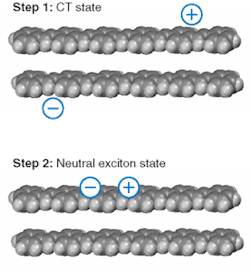Polymer OLED efficiency may double for long chains
The theoretical 25% efficiency limit for light production from organic light-emitting diodes (OLEDs) based on pi-conjugated polymers has been challenged by new calculations based on electron-transfer theory and reported this spring at the national meeting of the American Chemical Society (March 27–April 1; Anaheim, CA) by a team of scientists at universities on three continents. Organic-light-emitting-diode systems built from long polymer chains may actually offer efficiencies as high as 50%, according to team member Jean-Luc Brédas, at the Georgia Institute of Technology (Atlanta, GA) in collaboration with researchers from the University of Mons-Hainut (Mons, Belgium) and the Chinese Academy of Sciences (Beijing, China).1
When a voltage is applied across the electrodes on either face of a polymer-OLED thin film, electrons and holes migrate along the polymer chains until they meet and combine to form neutral excitons that decay to emit photons (see figure). During the two-step charge-recombination process, the spin directions of the electrons can orient into four possible combinations, each with an equal statistical likelihood, and resulting overall in either singlet or triplet exciton patterns.
Only the singlet exitons, which occur in just 25% of the recombinations, produce light in pi-conjugated polymers, however. "We really need these polymers to go beyond 25% for the devices to be more efficient," Brédas said. "Our theoretical work is oriented toward how we might have deviations in that statistical limit—how we can bias the spin statistics."
In long chains, electrons and holes that meet as triplets are believed to take much longer to decay into excitons. If another process—such as intersystem crossing or dissociation—intervenes before the decay into neutral excitons takes place, the loosely bound electron and hole charges in a triplet may transform into a singlet. In contrast, the singlet charge transfer states decay quickly, allowing little time for other processes to intervene.
"The calculations we have done based on electron transfer theory show that in short chains, the rates (to go from the charge transfer state to the neutral exciton state) are very fast for both singlets and triplets," he explained. "But when you get to longer chains, the rate of formation of singlets remains large, but the rate of formation of triplets slows considerably. This means that in longer chains, you can bias the spin statistics to produce more singlet neutral excitons than would be predicted."
Beyond demonstrating that the efficiency limit could be broken, the paper also suggests avenues—such as re-ordering the polymers or making substitutions in their backbones—that could boost these efficiency improvements. Brédas is working with experimental researchers to pursue that goal, and to study other applications for the materials in photovoltaics.
REFERENCE
- D. Beljonne et al., Advanced Functional Materials, in press.

